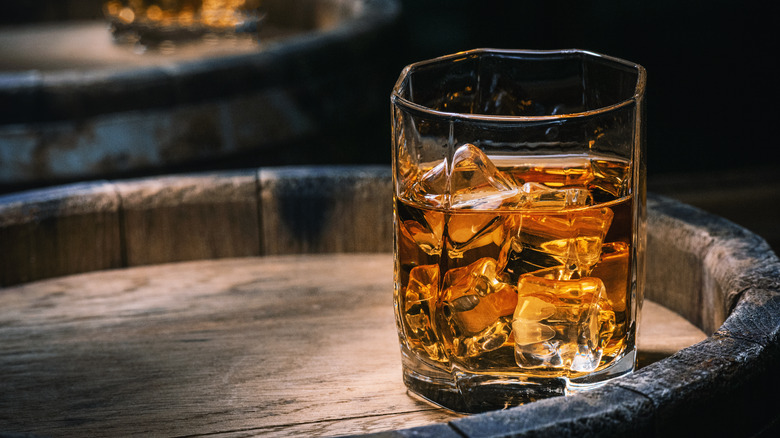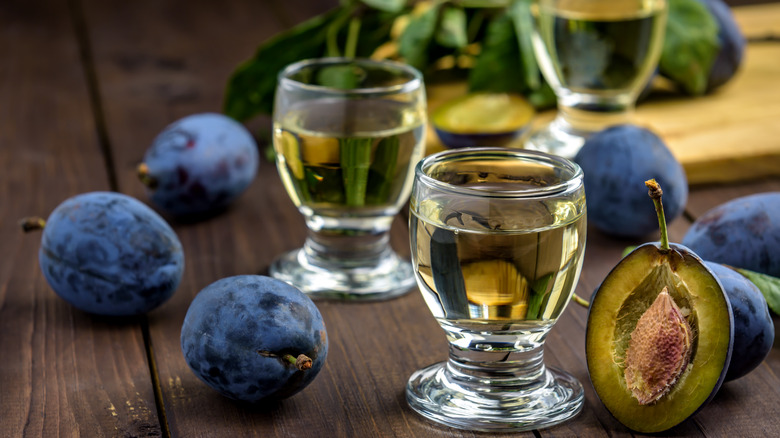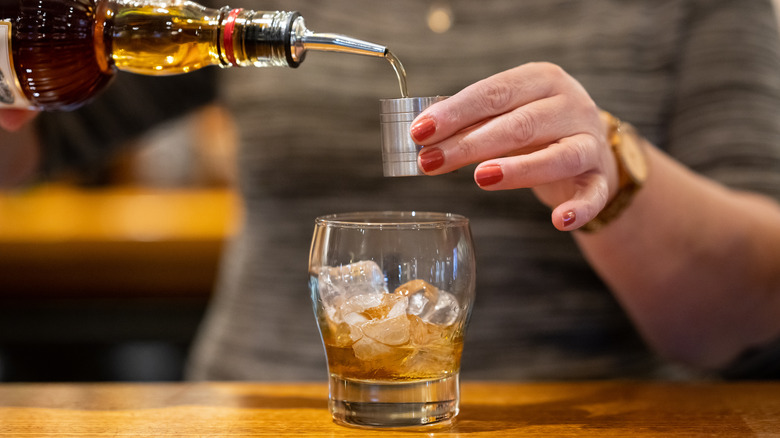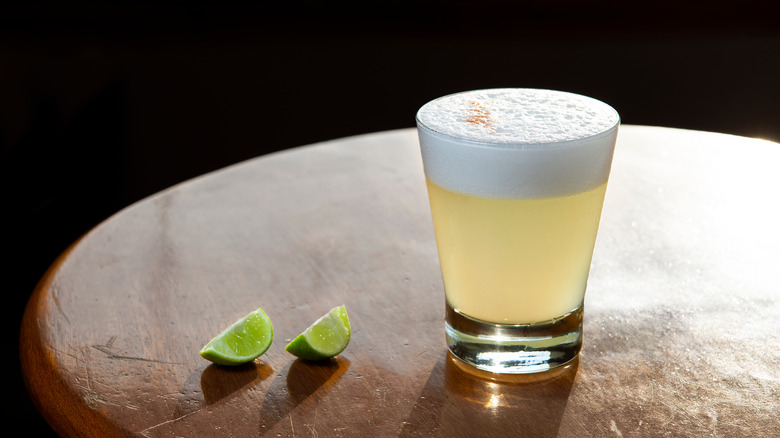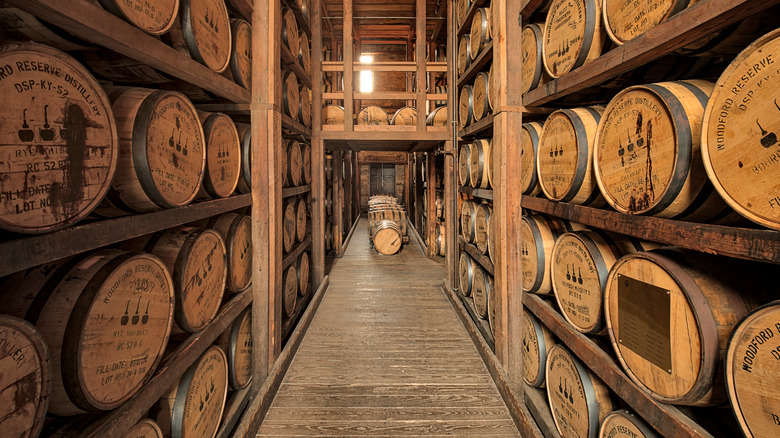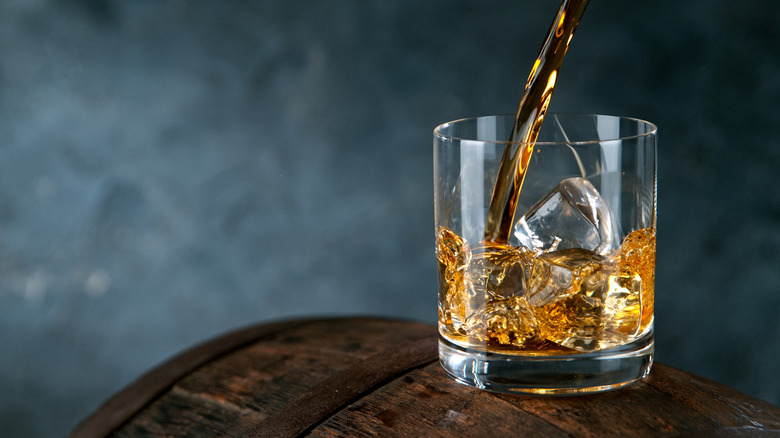Brandy Vs Whiskey: What's The Difference?
If you're a novice when it comes to liquor, you're not alone. There's a lot to learn, and it can sometimes be intimidating to order from your local bartender who throws around phrases like "oaky aftertaste" as though it's no big deal. (Don't get us wrong: we love our bartenders and their infinite wisdom.)
In the world of spirits, it's best to start with the basics: Where do these boozy drinks actually come from? What sets them apart from one another? Luckily, whiskey and brandy have fairly stark, easy-to-remember differences. At a glance, whiskey and brandy can be hard to differentiate: They can both come in varying hues of amber and brown, and both can be clear-colored, but many of the similarities stop there.
Whiskey comes from grains, including corn, rye, and barley. Brandy, on the other hand, comes from distilled fruits, like grapes and peaches. In fact — and this might blow your mind — by some metrics, brandy is more similar to wine than it is to whiskey. We'll explain.
What is brandy?
While brandy is a liquor, it often comes from wine. Think of it as fruit juice gone haywire. Brandy is created when fermented grape juice (wine) or another fermented fruit juice is distilled — evaporated and then condensed. The distillation process transforms the substance further, increasing its alcohol by volume (via VinePair).
Brandies come in varying shades and forms. Even if you're not a brandy enthusiast, there's a chance you've tried some without realizing it. Grappa, an Italian spirit made from grape seeds, stems, and skins, is categorized as a brandy, according to Wine Enthusiast. It does, after all, come from fruit, even if you get the sensation that it could burn your eyebrows clean off. And pisco, distilled in copper throughout coastal Peru, is technically a grape-based brandy (via Eater).
Then you've got the famous French cousins — Cognac and Armagnac. Yes, these are both grape-based brandies. They're produced respectively in the Cognac and Armagnac regions of France and cannot be distilled anywhere else (via Vinepair). While grapes are pretty common, brandy can be made from other fermented fruit juices — like the aptly named applejack, a brandy that's combined with bitters, fruit juices, and maple syrup.
What is whiskey?
Whiskey (aka the stuff Don Draper sips in virtually every episode of "Mad Men") has been around for centuries, though its origins are somewhat contested. Maybe Vikings had something to do with it? Or maybe Irish monks learned how to distill during their time in Arabia? Those theories are still up for debate, according to VinePair.
But we at least know how the drink is made. Different grain varieties — often appetizingly referred to as "grain mash" — are fermented, and then distilled (via Healthline). Typically, a whiskey is distilled two or even three times and can be aged in wood to incorporate additional flavor.
Like brandy, whiskey comes in many varieties, depending on how (and where) it's distilled, as well as which grains are used to create the liquor. Bourbon, for example, is a type of whiskey with some specific requirements. The spirit must contain at least 51% corn in its distillation process. Plus, it's got to be aged in a charred oak barrel for at least two years in the U.S., and the barrels must be brand new (via Food and Wine). High maintenance, right?
And while it might be self-explanatory, scotch is a variety of whiskey native to Scotland. Like bourbon, scotch must undergo a years-long aging process in an oak barrel. But instead of showcasing corn, scotch is typically distilled from a grain or malt mash. Rye whiskey, meanwhile, is made primarily from (you guessed it) rye.
Tastes and uses for brandy
While strong and fiery, brandy's usually described as having a sweet taste — it does, after all, come from fruit. (We don't mean "sweet" as in lemonade-flavored vodka, but more like "sweet" when compared to other strong liquors.) But when it comes to a spirit with as many varieties as brandy, it can be hard to string together an exact flavor or description. Food and Wine, for example, describes an old bottle of Martell VSOP Cognac as filled with notes of "dried figs, vanilla, and leather."
Grappa, on the other hand, is notably sharper and even abrasive in its flavor and sensation, though high-quality varieties can provide a smoother experience and even floral, herbal notes. And since it comes from fruit, what better way to pair brandy than with more fruity flavors? Take the classic, century-old Sidecar cocktail, in which cognac is shaken with orange liqueur and lemon. Or the Pisco sour, which uses fresh lime juice, simple syrup, and an egg white for its distinctive layer of cappuccino-like foam.
Brandy has more uses than cocktails, too. Kirsch, a cherry-based brandy, is beloved for its role in Black Forest cake. It's also one of the many brandies used to ignite cherries jubilee and other showy, flambé desserts. So the next time you'd like to impress your friends with bananas Foster, snag a bottle of kirsch or cognac (via Eater).
Taste and uses for whiskey
Whiskey also has a variety of tastes and experiences — perhaps an even wider range than that of brandy. Louisville-based bottler Barrell Craft Spirits literally says it's "impossible" to pin down a single description of the spirit.
Rye, the darling of the Manhattan cocktail, is relatively spicy, even "peppery." And bourbon whiskey has been described as containing traces of caramel and vanilla — even though bourbon cannot contain added flavorings. Supposedly, those flavors come from the distillation and aging process. Kind of magical, isn't it?
Whiskey plays a starring role in the simple-but-iconic Old-Fashioned, which typically combines bourbon (or rye) with sugar, bitters, and that lovely little twisted orange peel (via New York Times). The mint julep mixes bourbon with sugar, mint leaves, and ice — allowing the true flavors of the whiskey to shine.
The woodsy, complex flavors of whiskey can be an exciting culinary addition, too. Try reducing some whiskey with onion and garlic as a base for your next barbecue sauce, per AllRecipes. Or, include whiskey in your next bittersweet chocolate batter. You'll be able to appreciate the way this carefully crafted spirit can transform a simple dish.
Which has a higher ABV?
It's safe to say both brandy and whiskey are pretty darn boozy. Due to the range of distillation processes used in both spirits, it's tricky to categorize one as having a higher level of alcohol by volume. Insider describes whiskey as having an average of 40% ABV. But some whiskeys can soar above that 40% mark — like Stagg, a bourbon from distillery Buffalo Trace that can contain 70% ABV or higher (via New York Times). Yikes. Brandies, meanwhile, can typically range from 35% to 60% ABV, according to Insider.
The Kentucky-based Maker's Mark produces a handmade bourbon at 90 proof — or 45% ABV, per the brand. Cognac (a type of brandy, as discussed) must be 40% or higher, according to Food and Wine. Pisco, meanwhile, ranges from 38% to 48% ABV. Really, though, it's best to look at the bottle, and determine what tastes you're looking for — buttery vs. spicy, smooth vs. sharp, sweet vs. savory. The worlds of both brandy and whiskey have all that to offer and more.
